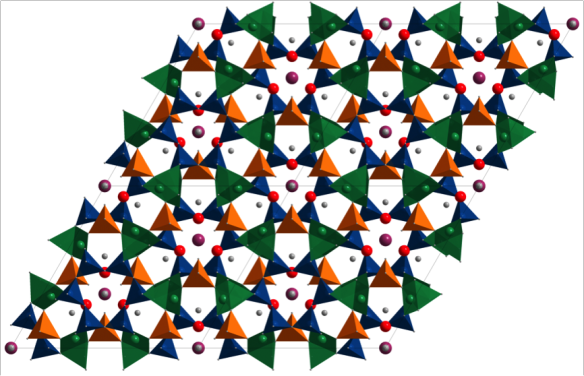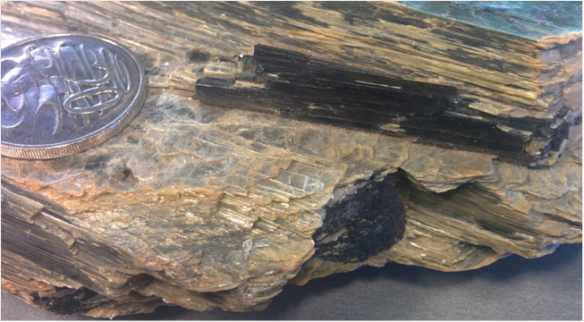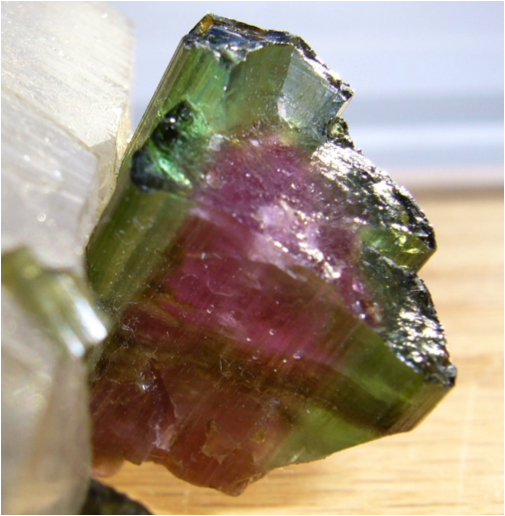The final birthstone of the year: Tourmaline
While many of the other birthstones we have investigated this year have had a definite colour to them – sapphire rather than ruby for example, this month's stone has something for everyone.
What does it look like?

Here is tourmaline. This picture was produced using the Diamond Crystal Structure Visualisation Package. Mg is red, Na is maroon, Al is green, Si is blue, O is grey and B orange.
What is it?
Tourmaline is a trigonal cyclo-silicate which typically forms large prismatic crystals. It has the formula (Ca,K,Na,)(Al,Fe,Li,Mg,Mn)3(Al,Cr,Fe,V)6(BO3)3(Si,Al,B)6O18(OH,F)4, which is a right mouthful! The structure has 6-membered rings of corner sharing Si and Al tetrahedra as well as BO3 tetrahedra. In the gaps between these large cations of Ca, K or Na can be found.
The brackets around some of the elements in the formula tell us that these elements are interchangeable on those sites. So clearly, there is a lot of scope for different compositions in tourmalines. This variation is what leads to the large variety of colours that tourmalines can come in. Tourmalines are some of the most chemically diverse minerals in the world.
Tourmalines are usually found in a range of igneous and metamorphic rocks, most commonly in granites and granite pegmatites (just like last month's birthstone). Mg–rich tourmalines tend to be restricted to schists and marbles.
There are three main types of tourmaline by composition:
- Schorl
Schorl is the most common type of tourmaline. They were named for the town in Germany where they were first found in large quantities. They are typically black to dark blue to brown in colour. Figure 2 shows a couple of schorl tourmalines in a large book of mica. Schorls are sodium – iron tourmalines.

Figure 2. Black Schorl tourmaline crystal.
- Dravites
Dravites are brown tourmalines. They are magnesium and sodium rich and typically vary from dark yellow to blue in colour but can also form deep green chromium and vanadium tourmaline varieties.
![Figure 3. from Wikipedia: By Vassil (Own work) [Public domain], via Wikimedia Commons](https://www.iycr2014.org/__data/assets/image/0019/109720/tournaline_3.png)
Figure 3. From Wikipedia: By Vassil (Own work) [Public domain], via Wikimedia Commons.
- Elbaite
Elbaites are lithium containing and show the most variation in colour. Elbaite was one of the minerals from which lithium was first discovered. They are named for the Italian island, Elba, where they abound. The most common forms are: Red – Rubellite, Light blue – green – Indiocolite, Green – Verdelite and colourless – Achroite. It is common to find variations in composition in zones within individual crystals. This leads to one of the most well-known tourmaline phenomena – watermelon tourmalines (see Figure 4).

Figure 4. Watermelon tourmaline. Image from: http://en.wikipedia.org/wiki/File:Watermelon_Tourmaline.JPG
With so much variation in colour, there really is something for everyone if you are born in December!
Where did the structure come from?
This structure came from :
Hamburger, G. E. and Buerger, M. J. (1948). The structure of tourmaline. American Mineralogist, 33, 532-540. It is available in the American Mineralogist Crystal Structure Database.






